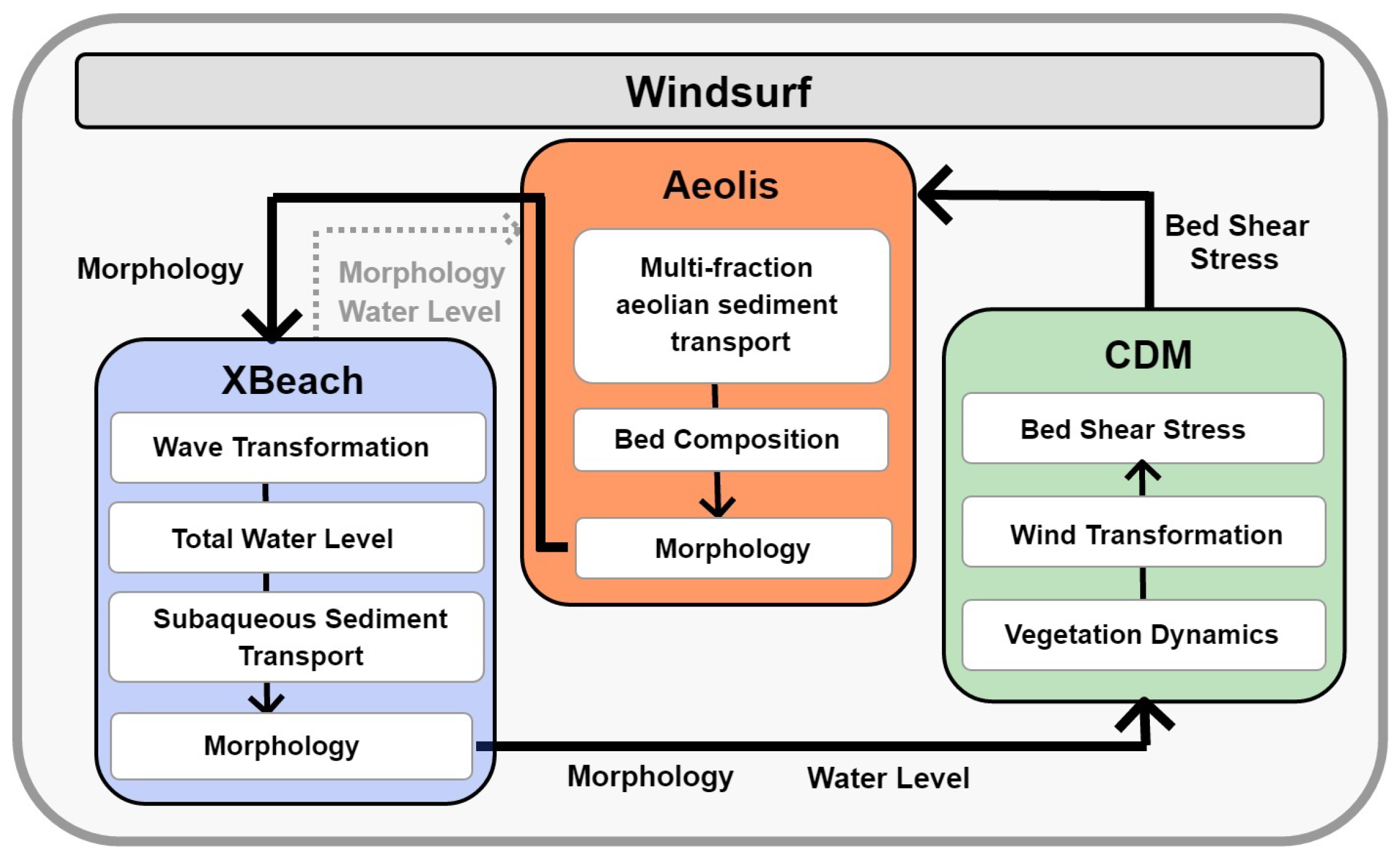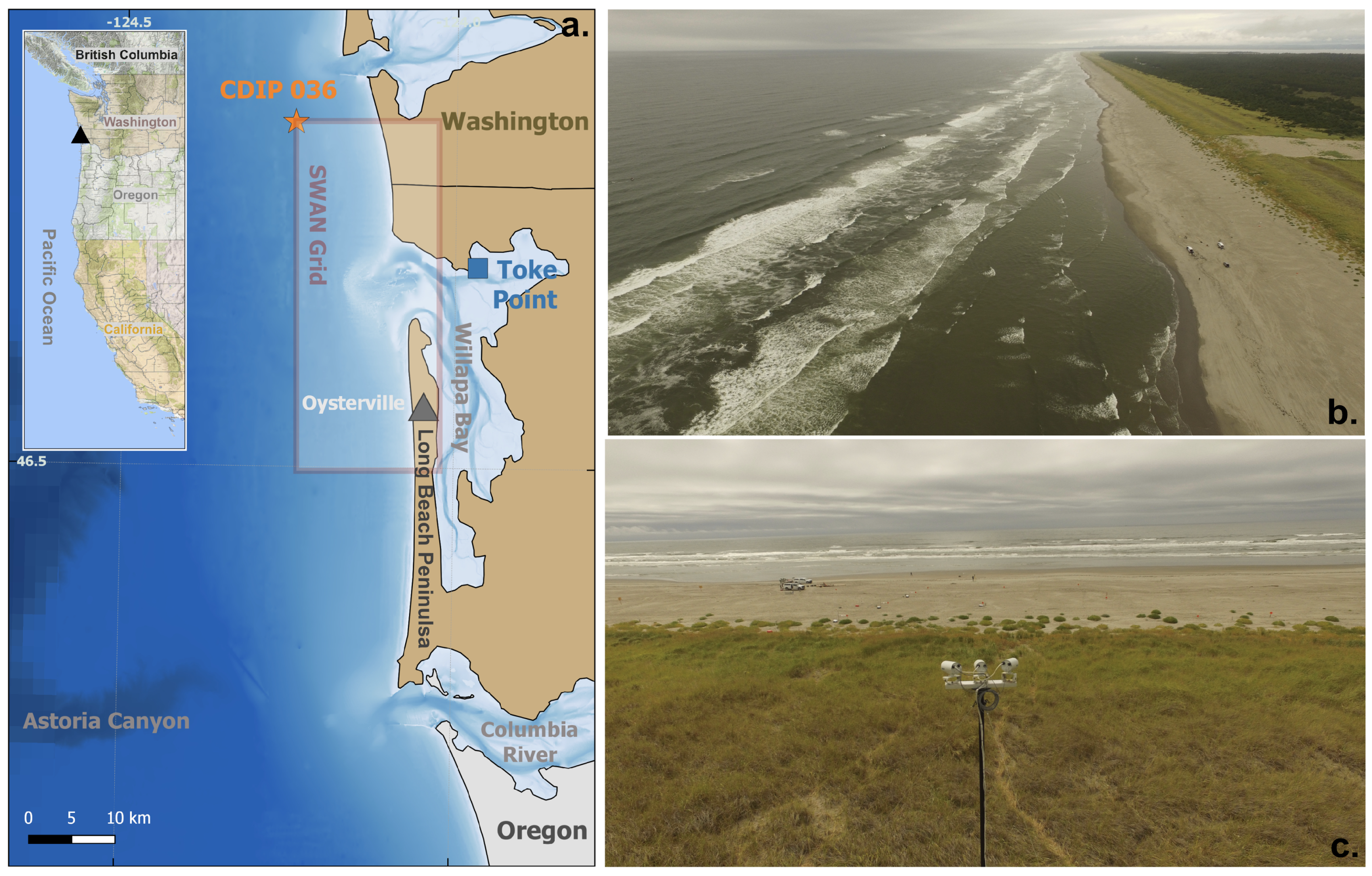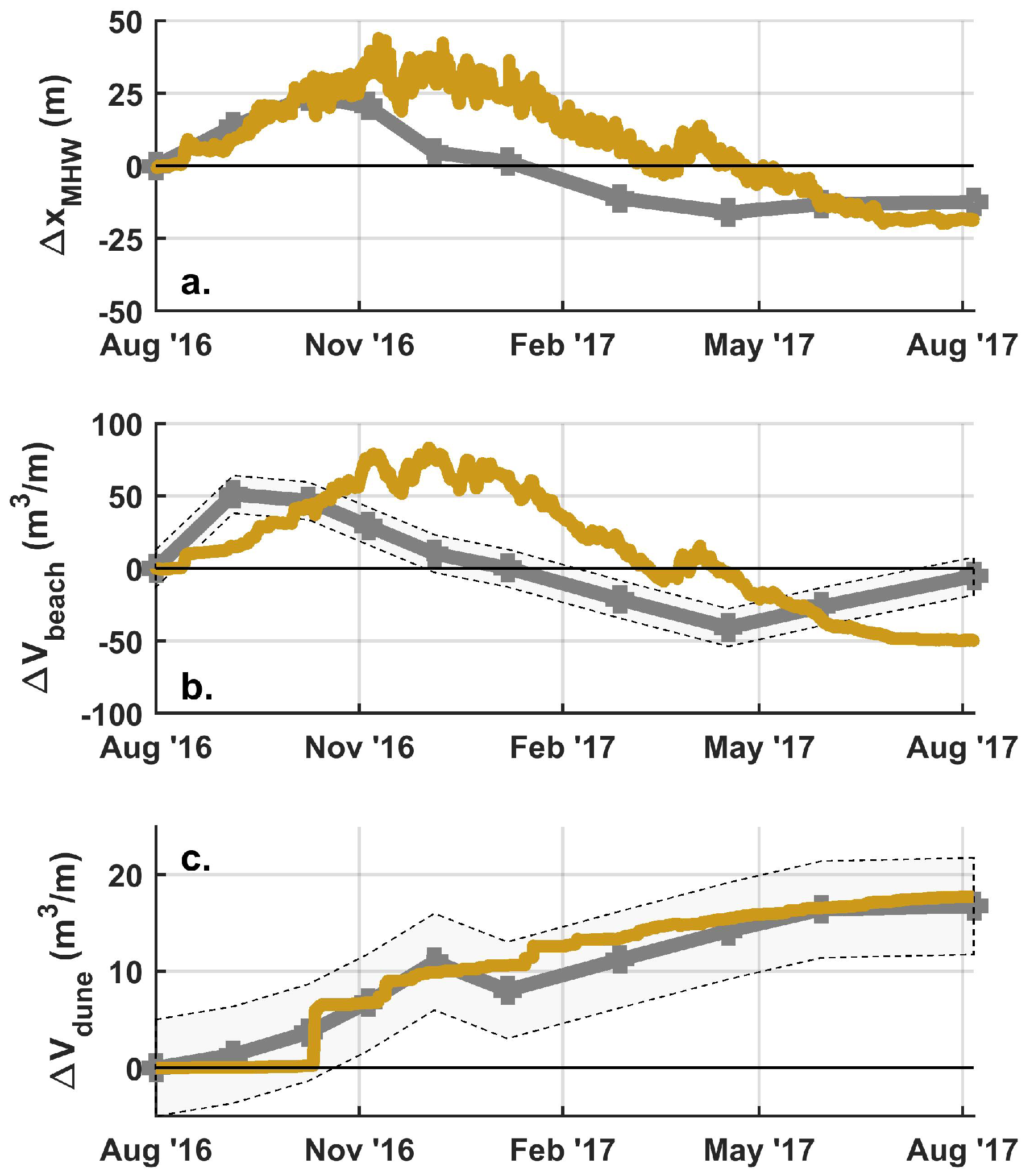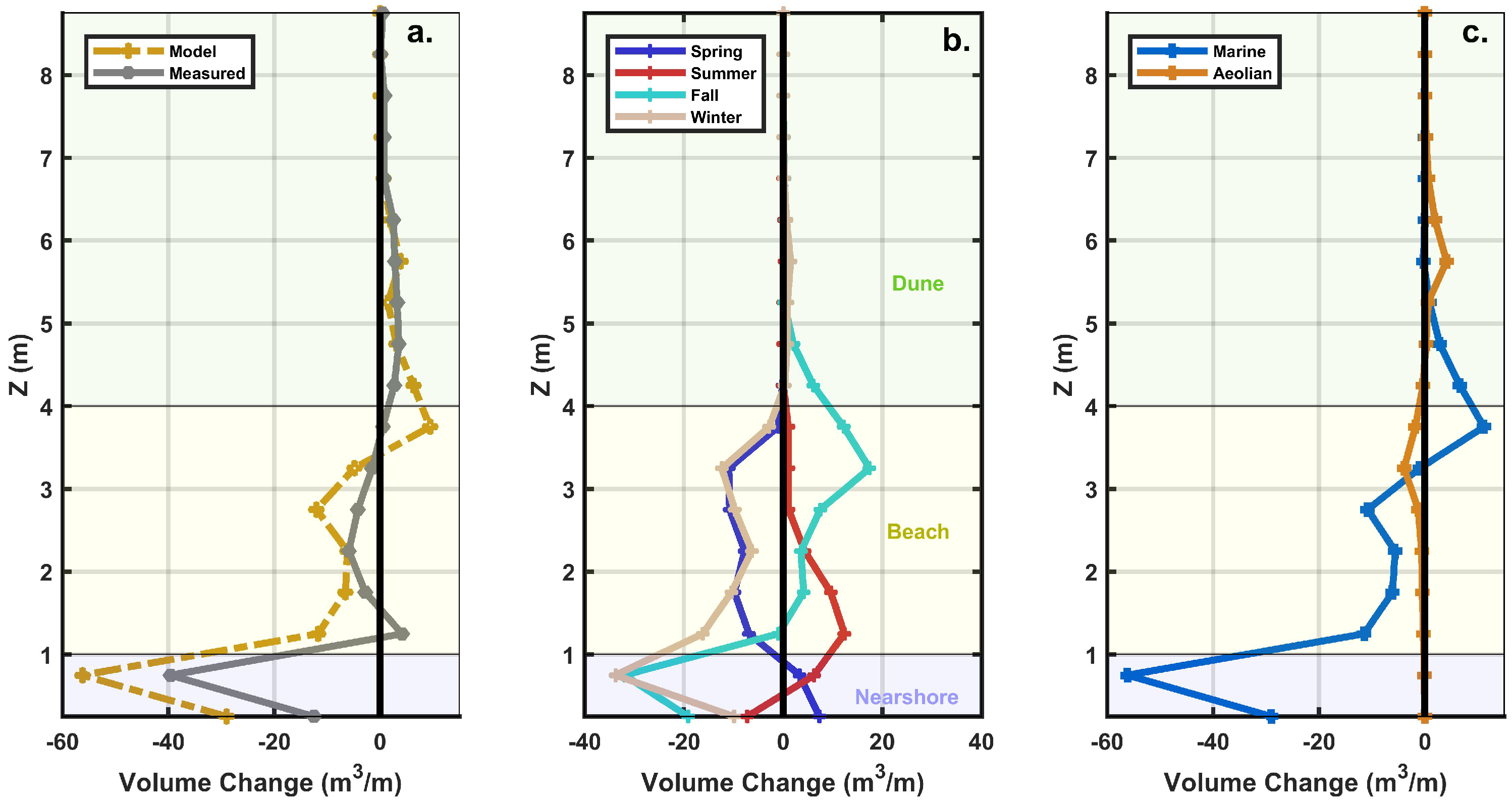Exploring Marine and Aeolian Controls on Coastal Foredune Growth Using a Coupled Numerical Model
Abstract
:1. Introduction
2. Windsurf Model Framework
2.1. Model Coupler
2.2. XBeach
2.3. Coastal Dune Model
2.4. Aeolis
3. Field Observations at a Prograding Coastal System
3.1. Field Setting
3.2. Morphology Data
3.2.1. Annual Scale
3.2.2. Sub-Annual Scale
3.3. Environmental Data
3.3.1. Water Levels
3.3.2. Waves
3.3.3. Wind
4. Hindcast Simulations
4.1. Windsurf Calibration
4.1.1. Model Setup
4.1.2. Calibration Procedure
4.2. Calibrated Model Results
5. Discussion
5.1. Insights into Physical Processes Controlling Dune Evolution
5.1.1. Aeolian Controls on Dune Growth
5.1.2. Marine Controls on Dune Growth
5.2. Sensitivity of Dune Growth to Environmental Perturbations
5.3. Windsurf Improvements and Future Applications
5.3.1. Model Processes and Parameterizations
5.3.2. External Sediment Supply
5.3.3. Computational Efficiency
5.3.4. Further Testing of Framework Limitations
6. Conclusions
Supplementary Materials
Author Contributions
Funding
Acknowledgments
Conflicts of Interest
References
- Cowell, P.; Thom, B.G. Morphodynamics of coastal evolution. In Coastal Evolution; Carter, R.W.G., Woodroffe, C.D., Eds.; Cambridge University Press: New York, NY, USA, 1995; pp. 33–86. [Google Scholar]
- Short, A.; Hesp, P. Wave, beach and dune interactions in southeastern Australia. Mar. Geol. 1982, 48, 259–284. [Google Scholar] [CrossRef]
- Komar, P. Beach Processes and Sedimentation; Prentice Hall: Upper Saddle River, NJ, USA, 1998. [Google Scholar]
- Wright, L.; Thom, B. Coastal depositional landforms. Prog. Phys. Geogr. Earth Environ. 1977, 1, 412–459. [Google Scholar] [CrossRef]
- Cowell, P.; Stive, M.; Niedoroda, A.; de Vriend, H.; Swift, D.; Kaminsky, G.; Capobianco, M. The coastal-tract (part 1): A conceptual approach to aggregated modeling of low-order coastal change. J. Coast. Res. 2003, 812–827. [Google Scholar]
- Gallop, S.L.; Collins, M.; Pattiaratchi, C.B.; Eliot, M.J.; Bosserelle, C.; Ghisalberti, M.; Collins, L.B.; Eliot, I.; Erftemeijer, P.L.A.; Larcombe, P.; et al. Challenges in transferring knowledge between scales in coastal sediment dynamics. Front. Mar. Sci. 2015, 2. [Google Scholar] [CrossRef]
- Ruggiero, P.; Kaminsky, G.M.; Gelfenbaum, G.; Cohn, N. Morphodynamics of prograding beaches: A synthesis of seasonal- to century-scale observations of the Columbia River littoral cell. Mar. Geol. 2016, 376, 51–68. [Google Scholar] [CrossRef] [Green Version]
- Sherman, D.J.; Bauer, B.O. Dynamics of beach-dune systems. Prog. Phys. Geogr. 1993, 17, 413–447. [Google Scholar] [CrossRef]
- Sallenger, A. Storm impact scale for barrier islands. J. Coast. Res. 2000, 16, 890–895. [Google Scholar]
- Elko, N.; Brodie, K.; Stockdon, H.; Nordstrom, K.; Houser, C.; McKenna, K.; Moore, L.; Rosati, J.; Ruggiero, R.; Thuman, R.; et al. Dune management challenges on developed coasts. Shore Beach 2016, 84, 15–28. [Google Scholar]
- Walker, I.J.; Davidson-Arnott, R.G.; Bauer, B.O.; Hesp, P.A.; Delgado-Fernandez, I.; Ollerhead, J.; Smyth, T.A. Scale-dependent perspectives on the geomorphology and evolution of beach-dune systems. Earth-Sci. Rev. 2017, 171, 220–253. [Google Scholar] [CrossRef]
- Arkema, K.K.; Guannel, G.; Verutes, G.; Wood, S.A.; Guerry, A.; Ruckelshaus, M.; Kareiva, P.; Lacayo, M.; Silver, J.M. Coastal habitats shield people and property from sea-level rise and storms. Nat. Clim. Chang. 2013, 3, 913–918. [Google Scholar] [CrossRef]
- Martínez, M.; Psuty, N. Coastal Dunes; Springer: Berlin, Germany, 2004. [Google Scholar]
- Miller, T.E.; Gornish, E.S.; Buckley, H.L. Climate and coastal dune vegetation: disturbance, recovery, and succession. Plant Ecol. 2010, 206, 97–104. [Google Scholar] [CrossRef]
- Sutton-Grier, A.E.; Wowk, K.; Bamford, H. Future of our coasts: The potential for natural and hybrid infrastructure to enhance the resilience of our coastal communities, economies and ecosystems. Environ. Sci. Policy 2015, 51, 137–148. [Google Scholar] [CrossRef] [Green Version]
- Psuty, N. The coastal foredune: A morphological basis for regional coastal dune development. In Coastal Dunes; Martínez, M., Psuty, N., Eds.; Springer: Berlin, Germany, 2004; pp. 11–27. [Google Scholar]
- Hesp, P.A. Conceptual models of the evolution of transgressive dune field systems. Geomorphology 2013, 199, 138–149. [Google Scholar] [CrossRef]
- Zinnert, J.C.; Stallins, J.A.; Brantley, S.T.; Young, D.R. Crossing Scales: The Complexity of Barrier-Island Processes for Predicting Future Change. BioScience 2016, 67, 39–52. [Google Scholar] [CrossRef]
- Luna, M.C.; Parteli, E.J.; Durán, O.; Herrmann, H.J. Model for the genesis of coastal dune fields with vegetation. Geomorphology 2011, 129, 215–224. [Google Scholar] [CrossRef]
- Van Dijk, P.M.; Arens, S.M.; van Boxel, J.H. Aeolian processes across transverse dunes. II: modelling the sediment transport and profile development. Earth Surf. Process. Landf. 1999, 24, 319–333. [Google Scholar] [CrossRef] [Green Version]
- Zarnetske, P.L.; Hacker, S.D.; Seabloom, E.W.; Ruggiero, P.; Killian, J.R.; Maddux, T.B.; Cox, D. Biophysical feedback mediates effects of invasive grasses on coastal dune shape. Ecology 2012, 93, 1439–1450. [Google Scholar] [CrossRef] [PubMed]
- Durán, O.; Moore, L.J. Vegetation controls on the maximum size of coastal dunes. Proc. Natl. Acad. Sci. USA 2013, 110, 17217–17222. [Google Scholar] [CrossRef] [PubMed] [Green Version]
- Keijsers, J.; Groot, A.D.; Riksen, M. Vegetation and sedimentation on coastal foredunes. Geomorphology 2015, 228, 723–734. [Google Scholar] [CrossRef]
- Davidson-Arnott, R.; Law, M. Measurement and prediction of long-term sediment supply to coastal foredunes. J. Coast. Res. 1996, 654–663. [Google Scholar]
- De Vries, S.; Southgate, H.; Kanning, W.; Ranasinghe, R. Dune behavior and aeolian transport on decadal timescales. Coastal Engineering 2012, 67, 41–53. [Google Scholar] [CrossRef]
- Houser, C. Synchronization of transport and supply in beach-dune interaction. Prog. Phys. Geogr. 2009, 33, 733–746. [Google Scholar] [CrossRef]
- Ollerhead, J.; Davidson-Arnott, R.; Walker, I.J.; Mathew, S. Annual to decadal morphodynamics of the foredune system at Greenwich Dunes, Prince Edward Island, Canada. Earth Surf. Process. Landf. 2012, 38, 284–298. [Google Scholar] [CrossRef]
- Davidson-Arnott, R.G.; MacQuarrie, K.; Aagaard, T. The effect of wind gusts, moisture content and fetch length on sand transport on a beach. Geomorphology 2005, 68, 115–129. [Google Scholar] [CrossRef]
- Nickling, W.G.; Ecclestone, M. The effects of soluble salts on the threshold shear velocity of fine sand. Sedimentology 1981, 28, 505–510. [Google Scholar] [CrossRef]
- Brakenhoff, L.; Smit, Y.; Donker, J.; Ruessink, G. Tide-induced variability in beach surface moisture: Observations and modelling. Earth Surf. Process. Landf. 2018. [Google Scholar] [CrossRef]
- Bauer, B.O.; Davidson-Arnott, R.G. A general framework for modeling sediment supply to coastal dunes including wind angle, beach geometry, and fetch effects. Geomorphology 2003, 49, 89–108. [Google Scholar] [CrossRef]
- Delgado-Fernandez, I. A review of the application of the fetch effect to modelling sand supply to coastal foredunes. Aeolian Res. 2010, 2, 61–70. [Google Scholar] [CrossRef] [Green Version]
- Hoonhout, B.M.; de Vries, S. A process-based model for aeolian sediment transport and spatiotemporal varying sediment availability. J. Geophys. Res. Earth Surf. 2016, 121, 1555–1575. [Google Scholar] [CrossRef] [Green Version]
- Bauer, B.; Davidson-Arnott, R.; Hesp, P.; Namikas, S.; Ollerhead, J.; Walker, I. Aeolian sediment transport on a beach: Surface moisture, wind fetch, and mean transport. Geomorphology 2009, 105, 106–116. [Google Scholar] [CrossRef]
- Davidson-Arnott, R.; Hesp, P.; Ollerhead, J.; Walker, I.; Bauer, B.; Delgado-Fernandez, I.; Smyth, T. Sediment Budget Controls on Foredune Height: Comparing Simulation Model Results with Field Data. Earth Surf. Process. Landf. 2018. [Google Scholar] [CrossRef]
- Jackson, D.W.T.; Cooper, A. Beach fetch distance and aeolian sediment transport. Sedimentology 1999, 46, 517–522. [Google Scholar] [CrossRef]
- Bascom, W.N. The relationship between sand size and beach-face slope. Trans. Am. Geophys. Union 1951, 32, 866. [Google Scholar] [CrossRef]
- Bagnold, R.A. The Transport of Sand by Wind. Geogr. J. 1937, 89, 409. [Google Scholar] [CrossRef]
- Carter, R.; Rihan, C. Shell and pebble pavements on beaches: Examples from the north coast of Ireland. CATENA 1978, 5, 365–374. [Google Scholar] [CrossRef]
- Neuman, C.M.; Li, B.; Nash, D. Micro-topographic analysis of shell pavements formed by aeolian transport in a wind tunnel simulation. J. Geophys. Res. Earth Surf. 2012, 117. [Google Scholar] [CrossRef] [Green Version]
- De Vries, S.; Arens, S.; de Schipper, M.; Ranasinghe, R. Aeolian sediment transport on a beach with a varying sediment supply. Aeolian Res. 2014, 15, 235–244. [Google Scholar] [CrossRef]
- De Vries, S.; Verheijen, A.; Hoonhout, B.; Vos, S.; Cohn, N.; Ruggiero, P. Measured spatial variability of beach erosion due to aeolian processes. In Proceedings of the Coastal Dynamics Conference 2017, Helsingør, Denmark, 12–16 June 2017. [Google Scholar]
- Hoonhout, B.; de Vries, S. Aeolian sediment supply at a mega nourishment. Coast. Eng. 2017, 123, 11–20. [Google Scholar] [CrossRef]
- Hoonhout, B.; de Vries, S. Field measurements on spatial variations in aeolian sediment availability at the Sand Motor mega nourishment. Aeolian Res. 2017, 24, 93–104. [Google Scholar] [CrossRef]
- Aagaard, T.; Davidson-Arnott, R.; Greenwood, B.; Nielsen, J. Sediment supply from shoreface to dunes: linking sediment transport measurements and long-term morphological evolution. Geomorphology 2004, 60, 205–224. [Google Scholar] [CrossRef]
- Cohn, N.; Ruggiero, P.; de Vries, S.; Kaminsky, G. New insights on the relative contributions of marine and aeolian processes to coastal foredune growth. Geophys. Res. Lett. 2018, 45, 4965–4973. [Google Scholar] [CrossRef]
- Stockdon, H.F.; Sallenger, A.H.; Holman, R.A.; Howd, P.A. A simple model for the spatially-variable coastal response to hurricanes. Mar. Geol. 2007, 238, 1–20. [Google Scholar] [CrossRef]
- Splinter, K.D.; Kearney, E.T.; Turner, I.L. Drivers of alongshore variable dune erosion during a storm event: Observations and modelling. Coast. Eng. 2018, 131, 31–41. [Google Scholar] [CrossRef]
- Saye, S.; van der Wal, D.; Pye, K.; Blott, S. Beach–dune morphological relationships and erosion/accretion: An investigation at five sites in England and Wales using LIDAR data. Geomorphology 2005, 72, 128–155. [Google Scholar] [CrossRef]
- Burroughs, S.M.; Tebbens, S.F. Dune Retreat and Shoreline Change on the Outer Banks of North Carolina. J. Coast. Res. 2008, 2, 104–112. [Google Scholar] [CrossRef]
- Cohn, N.; Ruggiero, P.; García-Medina, G.; Anderson, D.; Serafin, K.; Biel, R. Environmental and morphologic control on wave induced dune response. Geomorphology. in press. [CrossRef]
- Roelvink, D.; Reniers, A.; van Dongeren, A.; van Thiel de Vries, J.; McCall, R.; Lescinski, J. Modelling storm impacts on beaches, dunes and barrier islands. Coast. Eng. 2009, 56, 1133–1152. [Google Scholar] [CrossRef]
- Pender, D.; Karunarathna, H. A statistical-process based approach for modelling beach profile variability. Coast. Eng. 2013, 81, 19–29. [Google Scholar] [CrossRef] [Green Version]
- Stockdon, H.; Thompson, D.; Plant, N.; Long, J. Evaluation of wave runup predictions from numerical and parametric models. Coast. Eng. 2014, 92, 1–11. [Google Scholar] [CrossRef]
- De Winter, R.; Gongriep, F.; Ruessink, B. Observations and modeling of alongshore variability in dune erosion at Egmond aan Zee, the Netherlands. Coast. Eng. 2015, 99, 167–175. [Google Scholar] [CrossRef]
- McCall, R.; Van Thiel de Vries, J.; Plant, N.; Dongeren, A.V.; Roelvink, J.; Thompson, D.; Reniers, A. Two-dimensional time dependent hurricane overwash and erosion modeling at Santa Rosa Island. Coast. Eng. 2010, 57, 668–683. [Google Scholar] [CrossRef]
- Van Dongeren, A.; Bolle, A.; Vousdoukas, M.I.; Plomaritis, T.; Eftimova, P.; Williams, J.; Armaroli, C.; Idier, D.; Geer, P.V.; Van Thiel de Vries, J.; et al. MICORE: Dune erosion and overwash model validation with data from nine European field sites. In Proceedings of the Coastal Dynamics Conference, Tokyo, Japan, 7–11 September 2009; Mizuguchi, M., Sato, S., Eds.; World Scientific: Tokyo, Japan, 2009. [Google Scholar] [CrossRef]
- Buckley, M.; Lowe, R.; Hansen, J. Evaluation of nearshore wave models in steep reef environments. Ocean Dyn. 2014, 64, 847–862. [Google Scholar] [CrossRef]
- Roelvink, D.; McCall, R.; Mehvar, S.; Nederhoff, K.; Dastgheib, A. Improving predictions of swash dynamics in XBeach: The role of groupiness and incident-band runup. Coast. Eng. 2018, 134, 103–123. [Google Scholar] [CrossRef]
- Harley, M.; Armaroli, C.; Ciavola, P. Evaluation of XBeach predictions for a real-time warning system in Emilia-Romagna, Northern Italy. J. Coast. Res. 2011, 64, 1861–1863. [Google Scholar]
- Splinter, K.D.; Palmsten, M.L. Modeling dune response to an East Coast Low. Mar. Geol. 2012, 329–331, 46–57. [Google Scholar] [CrossRef]
- Splinter, K.D.; Carley, J.T.; Golshani, A.; Tomlinson, R. A relationship to describe the cumulative impact of storm clusters on beach erosion. Coast. Eng. 2014, 83, 49–55. [Google Scholar] [CrossRef]
- Verheyen, B.; Gruwez, V.; Zimmermann, N.; Wauters, P.; Bolle, A. Medium term time-dependent morphodynamic modelling of beach profile evolution in Ada, Ghana. In Proceedings of the 11th International Conference on Hydroscience and Engineering, Hamburg, Germany, 28 September–2 October 2014; Lehfeldt, R., Kopmann, R., Eds.; Bundesanstalt fuer Wasserbau: Karlsruhe, Germany, 2014. [Google Scholar]
- Ramakrishnan, R.; Agrawal, R.; Remya, P.; NagaKumar, K.; Demudu, G.; Rajawat, A.; Nair, B.; Rao, K.N. Modelling coastal erosion: A case study of Yarada beach near Visakhapatnam, east coast of India. Ocean Coast. Manag. 2018, 156, 239–248. [Google Scholar] [CrossRef]
- Roelvink, D.; van Dongeren, A.; McCall, R.; Hoonhout, B.; van Rooijen, A.; van Geer, P.; de Vet, L.; Nederhoff, K.; Quataert, E. XBeach Technical Reference: Kingsday Release; Technical report; Deltares: Delft, The Netherlands, 2015. [Google Scholar]
- Holthuijsen, L.; Booij, N.; Herbers, T. A prediction model for stationary, short-crested waves in shallow water with ambient currents. Coast. Eng. 1989, 13, 23–54. [Google Scholar] [CrossRef]
- Galappatti, G.; Vreugdenhil, C.B. A depth-integrated model for suspended sediment transport. J. Hydraul. Res. 1985, 23, 359–377. [Google Scholar] [CrossRef]
- Vousdoukas, M.I.; Ferreira, Ó.; Almeida, L.P.; Pacheco, A. Toward reliable storm-hazard forecasts: XBeach calibration and its potential application in an operational early-warning system. Ocean Dyn. 2012, 62, 1001–1015. [Google Scholar] [CrossRef]
- Simmons, J.A.; Harley, M.D.; Marshall, L.A.; Turner, I.L.; Splinter, K.D.; Cox, R.J. Calibrating and assessing uncertainty in coastal numerical models. Coast. Eng. 2017, 125, 28–41. [Google Scholar] [CrossRef]
- Dissanayake, P.; Brown, J.; Karunarathna, H. Impacts of storm chronology on the morphological changes of the Formby beach and dune system, UK. Nat. Hazards Earth Syst. Sci. 2015, 15, 1533–1543. [Google Scholar] [CrossRef] [Green Version]
- van Rhee, C. Sediment Entrainment at High Flow Velocity. J. Hydraul. Eng. 2010, 136, 572–582. [Google Scholar] [CrossRef]
- Reniers, A.J.H.M. Morphodynamic modeling of an embayed beach under wave group forcing. J. Geophys. Res. 2004, 109. [Google Scholar] [CrossRef] [Green Version]
- Reyns, J.; Dastgheib, A.; Ranasinghe, R.; Luijendijk, A.; Walstra, D.J.; Roelvink, D. Morphodynamic upscaling with the morfac approach in tidal conditions: the critical morfac. In Proceedings of the Coastal Engineering Conference, Seoul, Korea, 15–20 June 2014; Lynett, P., Ed.; Coastal Engineering Research Council: Seoul, Korea, 2014; p. 27. [Google Scholar] [CrossRef]
- Sauermann, G.; Kroy, K.; Herrmann, H.J. Continuum saltation model for sand dunes. Phys. Rev. E 2001, 64. [Google Scholar] [CrossRef] [PubMed]
- Durán, O.; Herrmann, H.J. Vegetation Against Dune Mobility. Phys. Rev. Lett. 2006, 97. [Google Scholar] [CrossRef]
- Parteli, E.J.R.; Durán, O.; Tsoar, H.; Schwämmle, V.; Herrmann, H.J. Dune formation under bimodal winds. Proc. Natl. Acad. Sci. USA 2009, 106, 22085–22089. [Google Scholar] [CrossRef] [Green Version]
- Schwämmle, V.; Herrmann, H.J. A model of Barchan dunes including lateral shear stress. Eur. Phys. J. E 2005, 16, 57–65. [Google Scholar] [CrossRef] [Green Version]
- Moore, L.J.; Vinent, O.D.; Ruggiero, P. Vegetation control allows autocyclic formation of multiple dunes on prograding coasts. Geology 2016, 44, 559–562. [Google Scholar] [CrossRef] [Green Version]
- Durán, O.; Moore, L.J. Barrier island bistability induced by biophysical interactions. Nat. Clim. Chang. 2015, 5, 158–162. [Google Scholar] [CrossRef]
- Goldstein, E.B.; Moore, L.J.; Vinent, O.D. Lateral vegetation growth rates exert control on coastal foredune hummockiness and coalescing time. Earth Surf. Dyn. 2017, 5, 417–427. [Google Scholar] [CrossRef] [Green Version]
- Weng, W.S.; Hunt, J.C.R.; Carruthers, D.J.; Warren, A.; Wiggs, G.F.S.; Livingstone, I.; Castro, I. Air flow and sand transport over sand-dunes. In Aeolian Grain Transport; Springer: Vienna, Austria, 1991; pp. 1–22. [Google Scholar]
- Hunt, J.C.R.; Leibovich, S.; Richards, K.J. Turbulent shear flows over low hills. Q. J. R. Meteorol. Soc. 1988, 114, 1435–1470. [Google Scholar] [CrossRef]
- Raupach, M.R.; Gillette, D.A.; Leys, J.F. The effect of roughness elements on wind erosion threshold. J. Geophys. Res. Atmos. 1993, 98, 3023–3029. [Google Scholar] [CrossRef]
- De Vries, S.; van Thiel de Vries, J.; van Rijn, L.; Arens, S.; Ranasinghe, R. Aeolian sediment transport in supply limited situations. Aeolian Res. 2014, 12, 75–85. [Google Scholar] [CrossRef]
- Belly, P. Sand Movement by Wind; Technical Report CERC Memorandum 1; U.S. Army Corps of Engineers: Vicksburg, MS, USA, 1964.
- Ruggiero, P.; Kaminsky, G.M.; Gelfenbaum, G.; Voigt, B. Seasonal to Interannual Morphodynamics along a High-Energy Dissipative Littoral Cell. J. Coast. Res. 2005, 213, 553–578. [Google Scholar] [CrossRef]
- Barnard, P.L.; Hoover, D.; Hubbard, D.M.; Snyder, A.; Ludka, B.C.; Allan, J.; Kaminsky, G.M.; Ruggiero, P.; Gallien, T.W.; Gabel, L.; et al. Extreme oceanographic forcing and coastal response due to the 2015–2016 El Niño. Nat. Commun. 2017, 8, 14365. [Google Scholar] [CrossRef] [Green Version]
- Cohn, N.; Ruggiero, P.; de Vries, S.; García-Medina, G. Beach growth driven by intertidal sandbar welding. In Proceedings of the Coastal Dynamics Conference, Helsingør, Denmark, 12–16 June 2017; pp. 1059–1069. [Google Scholar]
- Cohn, N.; Ruggiero, P. The influence of seasonal to interannual nearshore profile variability on extreme water levels: Modeling wave runup on dissipative beaches. Coast. Eng. 2016, 115, 79–92. [Google Scholar] [CrossRef]
- Gelfenbaum, G.; Stevens, A.W.; Miller, I.; Warrick, J.A.; Ogston, A.S.; Eidam, E. Large-scale dam removal on the Elwha River, Washington, USA: Coastal geomorphic change. Geomorphology 2015, 246, 649–668. [Google Scholar] [CrossRef] [Green Version]
- Hapke, C.; Himmelstoss, E.; Kratzmann, M.; List, J.; Thieler, E. National Assessment of Shoreline Change: Historical Shoreline Change along the New England and Mid-Atlantic Coasts; Technical Report Open-File Report 2010-1118; U.S. Geological Survey: Reston, VA, USA, 2011.
- Booij, N.; Ris, R.C.; Holthuijsen, L.H. A third-generation wave model for coastal regions: 1. Model description and validation. J. Geophys. Res. Oceans 1999, 104, 7649–7666. [Google Scholar] [CrossRef] [Green Version]
- Carignan, K.; Taylor, L.; Eakins, B.; Warnken, R. Digital Elevation Model of Astoria, Oregon: Procedures, Data Sources and Analysis; Technical Report NESDIS NGDC-22; U.S. National Oceanic and Atmospheric Administration, U.S. Dept. of Commerce: Boulder, CO, USA, 2009.
- Allan, J.; Ruggiero, P.; Cohn, N.; García-Medina, G.; Brien, F.O.; Serafin, K.; Stimley, L.; Roberts, J. Coastal Flood Hazard Study, Lincoln County, Oregon; Technical Report O-15-06; Oregon Department of Geology and Mineral Industries: Newport, OR, USA, 2015.
- Berard, N.A.; Mulligan, R.P.; da Silva, A.M.F.; Dibajnia, M. Evaluation of XBeach performance for the erosion of a laboratory sand dune. Coast. Eng. 2017, 125, 70–80. [Google Scholar] [CrossRef]
- Oreskes, N.; Belitz, K. Philosophical issues in model assessment. In Model Validation: Perspectives in hydrological science; Anderson, M., Bates, P., Eds.; John Wiley and Sons: Hoboken, NJ, USA, 2001; pp. 23–41. [Google Scholar]
- Thieler, E.; Pilkey, H.; Young, R.; Bush, D.; Chai, F. The use of mathematical models to predict beach behavior for US coastal engineering: A critical review. J. Coast. Res. 2000, 48–70. [Google Scholar]
- McCall, R.; Masselink, G.; Poate, T.; Roelvink, J.; Almeida, L. Modelling the morphodynamics of gravel beaches during storms with XBeach-G. Coast. Eng. 2015, 103, 52–66. [Google Scholar] [CrossRef] [Green Version]
- Hacker, S.D.; Zarnetske, P.; Seabloom, E.; Ruggiero, P.; Mull, J.; Gerrity, S.; Jones, C. Subtle differences in two non-native congeneric beach grasses significantly affect their colonization, spread, and impact. Oikos 2012, 121, 138–148. [Google Scholar] [CrossRef]
- Smyth, T.A.; Jackson, D.W.; Cooper, J.A.G. High resolution measured and modelled three-dimensional airflow over a coastal bowl blowout. Geomorphology 2012, 177–178, 62–73. [Google Scholar] [CrossRef]
- Smyth, T.A.; Hesp, P.A. Aeolian dynamics of beach scraped ridge and dyke structures. Coast. Eng. 2015, 99, 38–45. [Google Scholar] [CrossRef] [Green Version]
- Anthony, E.J. Beach-ridge development and sediment supply: examples from West Africa. Mar. Geol. 1995, 129, 175–186. [Google Scholar] [CrossRef]
- Peckham, S.D.; Hutton, E.W.; Norris, B. A component-based approach to integrated modeling in the geosciences: The design of CSDMS. Comput. Geosci. 2013, 53, 3–12. [Google Scholar] [CrossRef]










| Environmental Parameter | Local Measurement Transformed Dataset | Locally | RMSE | |
|---|---|---|---|---|
| SWL | AWAC | Toke Point | 0.29 m | 0.04 m |
| H | CDIP 46211 | 0.12 m | <0.01 m | |
| T | 1.7 s | 0.03 s | ||
| D | 8 | 0.3 | ||
| u | Dyacon | Toke Point | 1.13 m/s | −0.37 m/s |
| D | 25.5 | 0.2 |
| Model Parameter | Mode Core | Min Value Tested | Max Value Test | Calibrated Value |
|---|---|---|---|---|
| m | CDM | 0.005 | 0.20 | 0.104 |
| Cb | Aeolis | 0.20 | 1.50 | 0.370 |
| facSk(low energy) | XBeach | 0.10 | 0.50 | 0.123 |
| facSk(high energy) | 0.00 | 0.15 | 0.057 | |
| facAs(low energy) | 0.10 | 0.50 | 0.273 | |
| facAs(high energy) | 0.00 | 0.15 | 0.044 |
© 2019 by the authors. Licensee MDPI, Basel, Switzerland. This article is an open access article distributed under the terms and conditions of the Creative Commons Attribution (CC BY) license (http://creativecommons.org/licenses/by/4.0/).
Share and Cite
Cohn, N.; Hoonhout, B.M.; Goldstein, E.B.; De Vries, S.; Moore, L.J.; Durán Vinent, O.; Ruggiero, P. Exploring Marine and Aeolian Controls on Coastal Foredune Growth Using a Coupled Numerical Model. J. Mar. Sci. Eng. 2019, 7, 13. https://doi.org/10.3390/jmse7010013
Cohn N, Hoonhout BM, Goldstein EB, De Vries S, Moore LJ, Durán Vinent O, Ruggiero P. Exploring Marine and Aeolian Controls on Coastal Foredune Growth Using a Coupled Numerical Model. Journal of Marine Science and Engineering. 2019; 7(1):13. https://doi.org/10.3390/jmse7010013
Chicago/Turabian StyleCohn, Nicholas, Bas M. Hoonhout, Evan B. Goldstein, Sierd De Vries, Laura J. Moore, Orencio Durán Vinent, and Peter Ruggiero. 2019. "Exploring Marine and Aeolian Controls on Coastal Foredune Growth Using a Coupled Numerical Model" Journal of Marine Science and Engineering 7, no. 1: 13. https://doi.org/10.3390/jmse7010013






